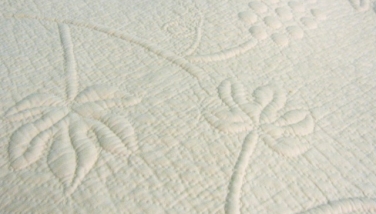Whitework: Elegance in Hand Stitching
Historic Odessa Foundation will exhibit several of its collection of white quilts this fall. This is a rare opportunity to see the extraordinary detail in these beautiful quilts, some from beds in the historic houses and some that are kept in storage and never on view.
Of all the quilts and whole cloth bed covers made in the eighteenth and early nineteenth centuries in America, the craft and artistry of design in white quilts is the most spectacular. Most often called “whitework”, these quilts showed off the excellent needlework skill and refined taste of ladies from wealthier families who had the time free of chores to spend on sewing elaborately figured large bed quilts. Also, new expensive fabric usually was used and the effort to clean and bleach the quilts after use was considerable, generally requiring a house –hold with many servants. Many of these white quilts are in fabulous condition after 250 years because, as special dowry quilts or guest bed pieces, they were seldom used or washed. During the 18th and 19th centuries the whitework style influenced stitched designs on bed hangings, petticoats and dressing table covers as well. Fine examples of these will be on display in the exhibit.
While figurative stitching dates back to the 14th century in Europe, especially found on clothing, in the 17th century hand stitched white quilts with padded designs, or “stuffed work”, became popular in Marseilles. American newspapers ads attest to these quilts being imported and called “Marseilles work”. After textile mills became mechanized in the 19th century Marseilles quilts were sewn by machine.
Whitework: Elegance in Hand Stitching will be in the Historic Odessa Foundation Bank lobby at the corner of Main Street and Second Street starting October 19th and on display through the holidays until December 30th.



